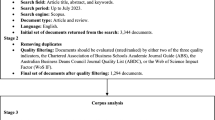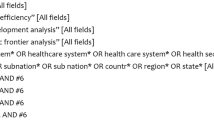Abstract
The paper deals with benchmarking cases where highly aggregated decision making units are in the data set. It is shown that these units—consisting of sub-units which are not further known by the evaluator—are likely to receive an unjustifiable harsh evaluation, here referred to as aggregation bias. To counter this bias, we present an approach which allows to calculate the potential sub-unit efficiency of a decision making unit by taking into account the possible impact of its sub-units’ aggregation without having disaggregated sub-unit data. Based on data envelopment analysis, the approach is operationalized in several ways. Finally, we apply our method to the benchmarking model actually used by the Brazilian Electricity Regulator to measure the cost efficiency of the Brazilian distribution system operators. For this case, our results reveal that the potential effect of the aggregation bias on the operators’ efficiency scores is enormous.




Similar content being viewed by others
References
Afsharian M, Ahn H, Thanassoulis E (2017) A DEA-based incentives system for centrally managed multi-unit organisations. Eur J Oper Res 259:587–598
Ahn H, Le MH (2015) DEA efficiency of German savings banks: evidence from a goal-oriented perspective. J Bus Econ 85:953–975
Andersen J, Bogetoft P (2007) Gains from quota trade: theoretical models and an application to the Danish fishery. Eur Rev Agric Econ 34:105–127
ANEEL (Agẽncia Nacional De Energia Elétrica) (2015) Metodologia de custos operacionais [operational costs methodology]. Technical note 66/2015. Brasilia
Bogetoft P (2000) DEA and activity planning under asymmetric information. J Prod Anal 13:7–48
Bogetoft P (2012) Performance benchmarking: measuring and managing performance. Springer, New York
Bogetoft P, Lopes A (2015) Comments on the Brazilian benchmarking model for energy distribution regulation: fourth cycle of tariff review—technical note 407/2014. http://nespufmg.com.br/content/upload/p/d3d9446802a44259755d38e6d163e820.pdf. Accessed 16 Dec 2017
Bogetoft P, Otto L (2011) Benchmarking with DEA, SFA, and R. Springer, New York
Bogetoft P, Pruzan P (1991) Planning with multiple criteria. North-Holland, Amsterdam
Bogetoft P, Wang D (2005) Estimating the potential gains from mergers. J Prod Anal 23:145–171
Bogetoft P, Boye K, Neergaard-Petersen H, Nielsen K (2007) Reallocating sugar beet contracts: can sugar production survive in Denmark? Eur Rev Agric Econ 34:1–20
Charnes A, Neralic L (1990) Sensitivity analysis of the additive model in data envelopment analysis. Eur J Oper Res 48:332–341
Charnes A, Rousseau J, Semple J (1996) Sensitivity and stability of efficiency classifications in data envelopment analysis. J Prod Anal 7:5–18
Färe R, Grosskopf S (2000a) Network DEA. Socio Econ Plan Sci 34:35–49
Färe R, Grosskopf S (2000b) Outfoxing a paradox. Econ Lett 69:159–163
Färe R, Zelenyuk V (2002) Input aggregation and technical efficiency. Appl Econ Lett 9:635–636
Färe R, Grosskopf S, Zelenyuk V (2004) Aggregation bias and its bounds in measuring technical efficiency. Appl Econ Lett 11:657–660
Farrell MJ (1957) The measurement of productive efficiency. J R Stat Soc 120:253–281
Fox KJ (1999) Efficiency at different levels of aggregation: public vs. private sector firms. Econ Lett 65:173–176
Fox KJ (2012) Problems with (dis)aggregating productivity, and another productivity paradox. Ann Oper Res 37:249–259
Frank CR Jr (1969) A generalization of the Koopmans–Gale theorem on pricing and efficiency. Int Econ Rev 10:488–491
Hackman ST (2010) Production economics: integrating the microeconomic and engineering perspectives. Springer, Berlin
Imanirad R, Cook WD, Zhu J (2013) Partial input to output impacts in DEA: production considerations and resource sharing among business subunits. Nav Res Logist 60:190–207
Kao C, Hwang S-N (2008) Efficiency decomposition in two-stage data envelopment analysis: an application to non-life insurance companies in Taiwan. Eur J Oper Res 185:418–429
Lozano S, Villa G (2004) Centralized resource allocation using data envelopment analysis. J Prod Anal 22:143–161
Ma J, Chen L (2018) Evaluating operation and coordination efficiencies of parallel-series two-stage-system: a data envelopment analysis approach. Expert Syst Appl 91:1–11
Rockafellar RT (1970) Convex analysis. Princeton University Press, Princeton
Simar L, Wilson PW (1999) Estimating and bootstrapping Malmquist indices. Eur J Oper Res 115:459–471
Sung T-J, Lu Y-T, Ho S-S (2010) Time-based strategy and business performance under environmental uncertainty: an empirical study of design firms in Taiwan. Int J Des 4(3):29–42
Tauer LW (2001) Input aggregation and computed technical efficiency. Appl Econ Lett 8:295–297
Tone K (2001) A slacks-based measure of efficiency in data envelopment analysis. Eur J Oper Res 130:498–509
Acknowledgements
The authors would like to thank the reviewers for their helpful comments. The first author gratefully acknowledges that this work was supported by the Deutsche Forschungsgemeinschaft (DFG) under Grant AH 90/5-1. The third author appreciates that this work was supported by the Fundação de Amparo à Pesquisa do Estado de Minas Gerais (FAPEMIG) and the Companhia Energética de Minas Gerais (CEMIG) under Grant APQ-03165-11; Coordenação de Aperfeiçoamento de Pessoal de Nível Superior (CAPES) under Grant 999999.000003/2015-08; Conselho Nacional de Desenvolvimento Científico e Tecnológico (CNPq) under Grant 444375/2015-5.
Funding
This work was supported by Deutsche Forschungsgemeinschaft (DFG) under Grant AH 90/5-1, Fundação de Amparo à Pesquisa do Estado de Minas Gerais (FAPEMIG) and Companhia Energética de Minas Gerais (CEMIG) under Grant APQ-03165-11, Coordenação de Aperfeiçoamento de Pessoal de Nível Superior (CAPES) under Grant 999999.000003/2015-08, Conselho Nacional de Desenvolvimento Científico e Tecnológico (CNPq) under Grant 444375/2015-5.
Author information
Authors and Affiliations
Corresponding author
Ethics declarations
Conflict of interest
Although one of the funds is supported by a company, there is no conflict of interest. The developed approach is universally applicable and of general interest for any benchmarking study.
Rights and permissions
About this article
Cite this article
Ahn, H., Bogetoft, P. & Lopes, A. Measuring potential sub-unit efficiency to counter the aggregation bias in benchmarking. J Bus Econ 89, 53–77 (2019). https://doi.org/10.1007/s11573-018-0901-0
Published:
Issue Date:
DOI: https://doi.org/10.1007/s11573-018-0901-0




